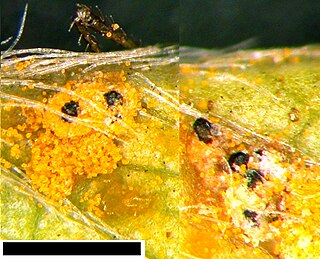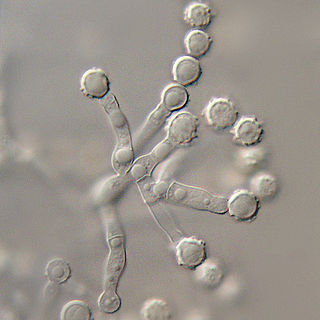Related Research Articles

The Hypocreales are an order of fungi within the class Sordariomycetes. In 2008, it was estimated that it contained some 237 genera, and 2647 species in seven families. Since then, a considerable number of further taxa have been identified, including an additional family, the Stachybotryaceae. Wijayawardene et al. in 2020 added more families and genera to the order. According to the Catalog of Life, As of April 2021 the Hypocreales contains 6 families, 137 genera, and 1411 species. Hyde et al. (2020a) listed 14 families under Hypocreales, while, Wijayawardene et al. (2022) accepted 15 families in the order, where Cylindriaceae was additionally added. Earlier, Hyde et al. (2020a) had placed Cylindriaceae in class Xylariomycetidae. Samarakoon et al. (2022) agreed. Hence, Cylindriaceae should have been excluded from Hypocreales and placed in Xylariomycetidae. Xiao et al. (2022) recently introduced a new family Polycephalomycetaceae to Hypocreales.

Stachybotrys is a genus of molds, hyphomycetes or asexually reproducing, filamentous fungi, now placed in the family Stachybotryaceae. The genus was erected by August Carl Joseph Corda in 1837. Historically, it was considered closely related to the genus Memnoniella, because the spores are produced in slimy heads rather than in dry chains. Recently, the synonymy of the two genera is generally accepted. Most Stachybotrys species inhabit materials rich in cellulose. The genus has a widespread distribution and contained about 50 species in 2008. There are 88 records of Stachybotrys on Species Fungorum, of which 33 species have DNA sequence data in GenBank. Species in the genus are commonly found in soil, plant litter and air and a few species have been found from damp paper, cotton, linen, cellulose-based building materials water-damaged indoor buildings, and air ducts from both aquatic and terrestrial habitats.

Hypocreomycetidae is a subclass of sac fungi.

The Phaeosphaeriaceae are a family of fungi in the order Pleosporales. Species in the family have a cosmopolitan distribution, and are generally nectrotrophic or saprobic on a wide range of plants.
The Halosphaeriaceae are a family of fungi in the Sordariomycetes class, subclass Hypocreomycetidae. Halosphaeriaceae is the family with the largest number of marine fungi with a few species are from freshwater and terrestrial habitats.

The Microascaceae are a family of fungi in the class Sordariomycetes, subclass Hypocreomycetidae. The family was published by David Malloch in 1970, an emended description based on Everet Stanley Luttrell's original 1951 publication. Family was updated in 2020.
The Melanosporales is a former order of fungi within the class Sordariomycetes.
Tengiomyces is a genus of fungi in the Coronophorales order of the Ascomycota. The relationship of this taxon to other taxa within the Sordariomycetes class is unknown, and it has not yet been placed with certainty into any family. This is a monotypic genus, containing the single species Tengiomyces indicus.

The Magnaporthales are an order of fungi within the class Sordariomycetes and subclass Diaporthomycetidae. It has several water based species and genera.
Gabarnaudia is a genus of anamorphic fungi that was placed in the family Ceratocystidaceae, until phylogenetic analysis by Hausner and Reid (2004) and De Beer et al. (2013a) showed that Gabarnaudia fimicolaG. betae and G. humicola clustered within genus Sphaeronaemella.
Gliomastix is a genus of fungi belonging to the family Bionectriaceae.
Evan Benjamin Gareth Jones is a British mycologist. His main area of research interest is aquatic fungi, particularly marine fungi. He has supervised about 100 PhD and MSc students, published approximately 600 research articles and is a highly cited scientist. Other research interests include marine biofouling, biodeterioration of materials, and wood decay by fungi.
Savoryellomycetidae is a subclass of sac fungi within the class of Sordariomycetes. It contains 4 known orders of Conioscyphales, Fuscosporellales, Pleurotheciales and Savoryellales.
Fuscosporellales is an order of fungi within the phylum of Ascomycota and in the class Sordariomycetes and subdivision of Pezizomycotina.
Savoryellaceae is a family of aquatic based fungi. It is the only family in the monotypic order Savoryellales within the class Sordariomycetes, division Ascomycota.
Savoryella is a genus of freshwater and marine based fungi in the family Savoryellaceae and the order Savoryellales.
Pseudodactylaria are a genus of fungi, within the monotypic family PseudodactylariaceaeCrous, and within the monotypic order PseudodactylarialesCrous, within the class Sordariomycetes. They are saprobic on plants in freshwater or terrestrial habitats.
Pararamichloridium is a genus of fungi in the monotypic family Pararamichloridiaceae and within the monotypic order of Pararamichloridiales and also in the subclass Hypocreomycetidae. They are saprobic on wood in terrestrial and freshwater habitats.

The Torpedosporales are an order of marine based fungi in the class Sordariomycetes, subclass Hypocreomycetidae. Most are found on wood substrates in the water.
Torpedosporaceae is a monotypic family of ascomycetous marine based fungi within the order of Torpedosporales in the subclass Hypocreomycetidae and within the class Sordariomycetes. They are saprobic on intertidal mangrove wood and roots, bark leaves, and sand in various marine habitats.
References
- 1 2 3 Yang, Jing; Maharachchikumbura, Sajeewa S. N.; Bhat, D. Jayarama; Hyde, Kevin D.; McKenzie, Eric H. C.; Gareth Jones, E. B.; Al-Sadi, Abdullah M.; Lumyong, Saisamorn (1 December 2016). "Fuscosporellales, a New Order of Aquatic and Terrestrial Hypocreomycetidae (Sordariomycetes)". Cryptogamie, Mycologie. 37 (4): 449–475. doi:10.7872/crym/v37.iss4.2016.449.
- ↑ Wijayawardene, Nalin; Hyde, Kevin; Al-Ani, Laith Khalil Tawfeeq; Somayeh, Dolatabadi; Stadler, Marc; Haelewaters, Danny; et al. (2020). "Outline of Fungi and fungus-like taxa". Mycosphere. 11: 1060–1456. doi: 10.5943/mycosphere/11/1/8 .
- ↑ Wijayawardene, N.N.; Hyde, K.D.; Dai, D.Q.; Sánchez-García, M.; Goto, B.T.; Saxena, R.K.; et al. (2022). "Outline of Fungi and fungus-like taxa – 2021". Mycosphere. 13 (1): 53–453 [160]. doi: 10.5943/mycosphere/13/1/2 . S2CID 249054641.
- ↑ "spore | Etymology, origin and meaning of spore by etymonline". www.etymonline.com. Retrieved 8 June 2023.
- ↑ Boonyuen, Nattawut; Chuaseeharonnachai, Charuwan; Suetrong, Satinee; Sommai, Sujinda; Somrithipol, Sayanh (December 2016). "Parafuscosporella garethii sp. nov. (Fuscosporellales) from a rivulet in a community-based northern forest, in Thailand". Mycosphere. 7 (9): 1265–1272. doi: 10.5943/mycosphere/7/9/2 .
- ↑ Yang, J.; Liu, J.K.; Hyde, Kevin D.; Jones, E.B.G.; Liu, Z.Y. (2017). "Two new species in Fuscosporellaceae from freshwater habitats in Thailand". Mycosphere. 8 (10): 1893–1903. doi: 10.5943/mycosphere/8/10/12 .
- ↑ "Fuscosporella - Search Page". www.speciesfungorum.org. Species Fungorum. Retrieved 5 June 2023.
- ↑ Xu, Xia; Wijayawardene, Nalin; Long, Chunsheng; Li, Xiaobing; Cheng, Min; Wang, Di; Wang, Meizhu; Wang, Feng; Liu, Yanxia; Li, Qirui; Kan, Yingqian (May 2022). "A New Species (Fuscosporella xingyiensis sp. nov.) and a New Record (Sporoschisma chiangraiense) of Wood-Decay Fungi from Guizhou, China". Chiang Mai Journal of Science. 49 (3): 718–729. doi: 10.12982/CMJS.2022.056 .
- ↑ Wijayawardene, N.N.; Dissanayake, L.S.; Dai, D.-Q.; Li, Q.-R.; Xiao, Y.; Wen, T.-C.; Karunarathna, S.C.; Wu, H.-X.; Zhang, H.; Tibpromma, S.; Kang, J.C. (2021). "Yunnan–Guizhou Plateau: A mycological hotspot". Phytotaxa. 523: 1–31.
- ↑ "Fuscosporella Jing Yang, Bhat & K.D.Hyde, 2016". www.gbif.org. Retrieved 5 June 2023.
- ↑ Hyde, Kevin D.; Norphanphoun, C.; Maharachchikumbura, S.S.N.; Bhat, D.J.; Jones, E.B.G.; Bundhun, D.; Chen, Y.J.; Bao, D.F.; Boonmee, S.; Calabon, M.S.; Chaiwan, N.; Chethana, K.W.T.; Dai, D.Q.; Dayarathne, M.C.; Devadatha, B.; Dissanayake, A.J.; Dissanayake, L.S.; Doilom, M.; Dong, W.; Fan, X.L.; Goonasekara, I.D.; Hongsanan, S.; Huang, S.K.; Jayawardena, R.S.; Jeewon, R.; Karunarathna, A.; Konta, S.; Kumar, V.; Lin, C.G.; Liu, J.K.; Liu, N.G.; Luangsa-ard, J.; Lumyong, S.; Luo, Z.L.; Marasinghe, D.S.; McKenzie, E.H.C.; Niego, A.G.T.; Niranjan, M.; Perera, R.H.; Phukhamsakda, C.; Rathnayaka, A.R.; Samarakoon, M.C.; Samarakoon, S.M.B.C.; Sarma, V.V.; Senanayake, I.C.; Shang, Q.J.; Stadler, M.; Tibpromma, S.; Wanasinghe, D.N.; Wei, D.P.; Wijayawardene, N.N.; Xiao, Y.P.; Yang, J.; Zeng, X.Y.; Zhang, S.N.; Xiang, M.M. (2020). "Refined families of Sordariomycetes". Mycosphere. 11: 305–1059. doi:10.5943/mycosphere/11/1/7. hdl: 10033/622756 .
- ↑ Du, Hong-Zhi; Yang, Jing; Liu, Ning-Guo; Cheewangkoon, Ratchadawa; Liu, Jian-Kui (2022). "Morpho-Phylogenetic Evidence Reveals New Species of Fuscosporellaceae and Savoryellaceae from Freshwater Habitats in Guizhou Province, China". J. Fungi. 8 (11): 1138. doi: 10.3390/jof8111138 . PMC 9696266 . PMID 36354905.